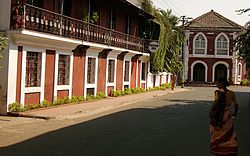Fontainhas (quarter)
|
Bairro das Fontainhas Fontainhas Quarter |
|
|---|---|
| Nighbourhood | |

Heritage houses in a lane in Fontainhas
Chapel of St Sabastian |
|
| Coordinates: 15°29′46″N 73°49′52″E / 15.496°N 73.831°ECoordinates: 15°29′46″N 73°49′52″E / 15.496°N 73.831°E | |
| Country |
|
| State | Goa |
| District | North Goa |
| Sub-Division | Ilhas de Goa |
| Established | 1770 |
| Founded by | Antonio Joao de Sequeira |
| Elevation | 8 m (26 ft) |
| Population (2011) | |
| • Total | approx 3,500 |
| Demonym(s) | - |
| Languages | |
| • Official | Konkani |
| • Also Spoken (understood) | English |
| • Historical | Portuguese |
| Religions | |
| • Dominant | Roman Catholicism |
| Time zone | IST (UTC+5:30) |
| Postcode | 403 517 |
| Telephone code | 0832 2xx |
| Vehicle registration | GA |
| Website | goa |
Fontainhas (or Bairro das Fontainhas, in Portuguese) is an old Latin Quarter in Panjim, capital city of the state of Goa, India. It maintains to this day its Portuguese influence, namely at the architectonic level, such as narrow and pretty winding streets as found in many European cities, old villas and buildings with projecting balconies painted in the traditional tones of pale yellow, green, or blue, and roofs made of red colored tiles. The Fontainhas' heritage ambiance represents the traditional Portuguese influence in the area.
Fontainhas is the oldest Latin quarter of Panjim, akin to a Mediterranean city. Located at the foot of the hills, it is bounded on the west side by the Altinho hills with springs, after which it derived its name. On the east side, it is bounded by an ancient creek known as the Ourem creek. It was built on reclaimed land.
In the late eighteenth century, a Goan expatriate named Antonio Joao de Sequeira (nicknamed Mossmikar), who had made his wealth while working in Mozambique, established Fontainhas on reclaimed land. Fontainhas (which means “little fountain” in Portuguese and gets its name from the fountain at the foot of the hill (which began to sprout around 1770). It is patterned along the lines of Lisbon’s Bairo Alto.
In 1844, an administrator of the Government who had restored a certain degree of law and order in Goa directed that even the people of the lower strata of society should appear properly dressed in public. He built an elegant street with a parapet called the Rua Nova d’Ouremsea on the seaward side of the Fontainhas Bairro (Quarter). In the same area, he also created the Phenis fountain, which had a fine façade and porch.
The Fontainhas had a high population density. The rich people lived on Panjim hill in large bungalows, while the less affluent lived at the foot and the east of the hill, hemmed between the hill and the small tidal creek, which remains dry and emits a foul smell during the low flow season.
William Dalrymple calls Fontainhas a "small chunk of Portugal washed up on the shores of the Indian Ocean". It is the only area in Goa where Portuguese is still the main spoken language.
...
Wikipedia


